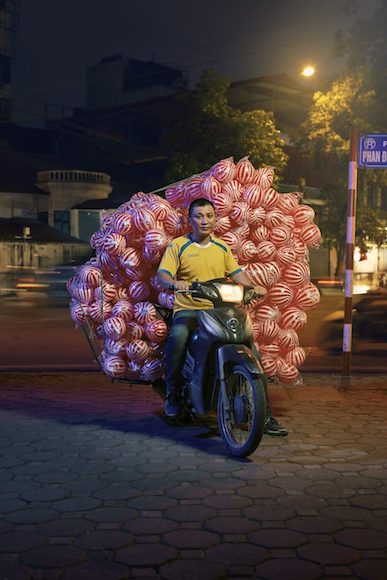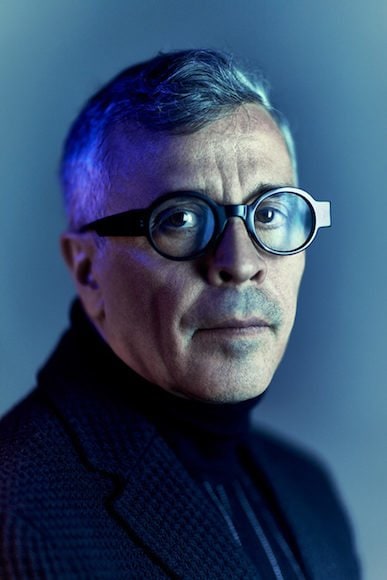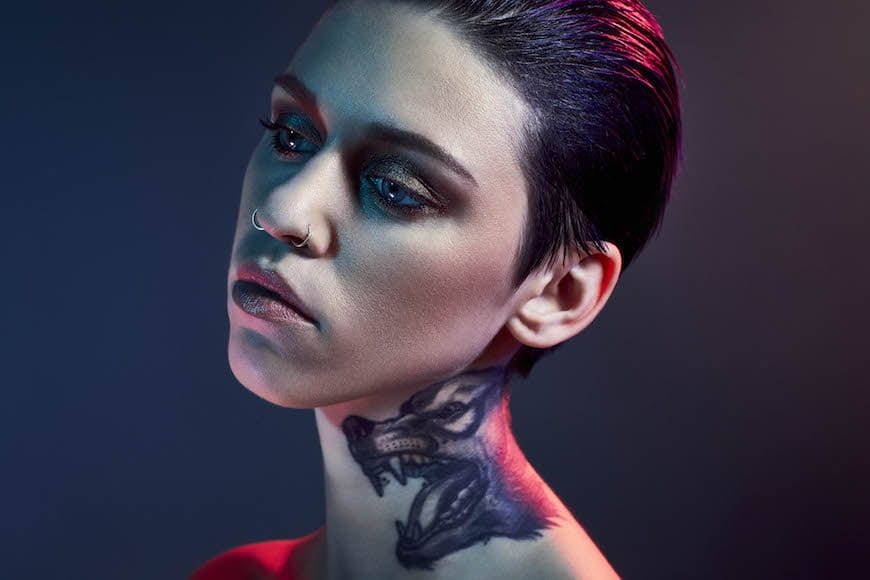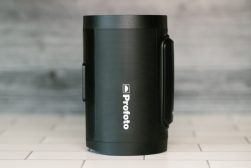









Jon Enoch
Lifestyle | Last Updated: February 23, 2021
I’m Jon Enoch and I am a London-based lifestyle and advertising photographer. I work with design and advertising agencies, as well as directly with brands. I also specialise in portrait photography, working with sportspeople, CEOs, and other figures.
I always describe my approach as being bold and uncomplicated. I love playing with light and how that affects the mood and personality of the end result.
My ‘Bikes of Hanoi’ project won a gold award in the Prix de la Photographie Paris (Px3) award last year, as well as being shortlisted for the Sony World Photography Awards.
I have also won and been shortlisted for a number of Association Of Photographer awards.
Inspiration can come from absolutely anywhere. I live in London, so just living in the city pushes you up against all sorts of stimuli.
Music, films, art – you name it, it all blends into the mix. I also enjoy the technical challenges involving locations and lighting and then turning that into a creative and compelling image that evokes emotion.
I discovered photography by accident, but I soon knew it was something I was going to pursue professionally. When I started university, I entered a competition and quickly forgot all about it.
A couple of weeks later, a PR agency rang me and told me that I’d won a free trip around the world, with all flights and expenses paid for.
I spoke to my tutors, who all agreed that this was an opportunity I couldn’t turn down and that I could defer my course for a year. So off I went.
I bought myself a small point-and-shoot camera, so I could document my travels, and that was how I developed my love of photography.
I did go back to university to finish my geography degree, but after that, I did a one-year news photography course. I started my career as a news photographer in a regional newspaper and then went onto work for a news agency.
Early on in my career, I got a call from a music publication that was looking for a photographer to go and shoot a gig.
I turned up in a tiny pub in Sheffield, and that band turned out to be the Arctic Monkeys, so that turned out to be a huge opportunity for me but I didn’t know it until I said yes and just grabbed that chance.
I decided to move to London and quite quickly got a freelance job at The Times, which led to me developing my portrait skills.
I decided this is the direction I wanted to take my career and I’ve never looked back. I signed up with a fantastic agent and have developed a tight portfolio of lifestyle and portrait imagery (see guide).
I learned some really important skills from news photography, which I have carried over with me. One of the most important lessons is to realise that there is never an ideal situation to get a photograph and to work as quickly as possible.
As a news photographer, I might have been jostling with ten other photographers trying to get the right shot, and as a portrait photographer I might only have a ten-minute slot with a premiership footballer before they are chauffeured away.
I don’t tend to get stressed, even if things go wrong. From experience, I know that getting stressed can just make everything worse. I work well under pressure and am pretty decisive.
Kit Details
Canon EOS 5D IV: My go-to body for most shoots. The image quality is obviously outstanding, and I have used all of the Canon EOS 5D IV range throughout my career, so using this camera is second nature.
The file sizes are impressive and hold up for the vast majority of work.
Canon EOS 5DS R: This is my go-to body when in the studio and things are a little more controlled. There is a step up in file size over the IV but the camera needs more love and care.
It’s very unforgiving but performs wonderfully when everything is controlled. The larger file sizes allow me to shoot with crop space or when the extra resolution is a must.
Fuji X100: This is my travel camera, mostly used when location scouting. A lot of my work takes me to interesting places so this is the one I stick in my pocket when I’m out and about.
It’s a lovely camera to use and the unobtrusive shape and size mean I’m quite often able to capture images where a full SLR would get too much attention.
The ability to shoot raw means if you get a good frame it can happily sit in my portfolio alongside the rest of my work.
Canon 70-200mm f/2.8: If I’m honest, this is a very rarely used lens but one I can’t quite leave behind as you never quite know when you will need the additional range.
I have had this one for years. Every time I think of leaving it behind, it saves the day.
Profoto Zoom Spot: I love this modifier and use it quite often as the key light, which is a little unusual. But it can really add some drama to a scene.
It’s so lightweight and small compared to most spots which means I tend to have it with me when I’m stuck.
Its ability to create hard shadow and dramatic contrast is unrivaled and it can turn the drabbest room into something quite powerful.
Sigma 20mm f/1.4: This is a recent addition. I used to have a wide Canon zoom that covered off the wider focal lengths but I just got too used to the quality of the primes, so I was always really disappointed with the image quality.
So this lens doesn’t get much use – it’s far too wide for most portrait images but on that occasional job where things are very tight, it’s good to know it’s there.
Sigma 35mm f/1.4: I tend to prefer something a little tighter but for more lifestyle work, where I need a little bit more room for the subjects to play with, it’s a great little lens.
Sigma 50mm f/1.4: My favourite of the range I would probably say. Again like all the art lenses, it’s not lightweight but again open it up and you get some wonderful drop-off.
Again, the build quality (like the Profoto gear) is top of the range. I’m shooting three, four times a week and with these lenses and you really get the impression nothing is going to let you down.
Canon 85mm f/1.2: The sharpness and quality are immense. The wide aperture can also give you something.
I quite often shoot wide open at 1.2 or 1.4 to really draw the viewer into the eyes. Again, it’s a heavy lens but the quality more than makes up for the weight.
Manfrotto 190: I love this little tripod – it’s my go-to for most location work. I might hire in something more substantial for a studio shoot but for location work this more than does the job for me.
The innovative mechanism allowing the vertical column to swing to the horizontal position really increases shooting flexibility
Profoto D2s: I keep two of these in my kit and form the core of my studio kit. It’s the build quality that I love – they are built like tanks. They are simple to use so you can sort out any issues that might crop up on a shoot.
Alongside the D2s, I also have a couple of Profoto B1 – not quite the power of the D2s but the battery element makes these my go-to for any location work.
I might even throw this up on a studio shoot too as a clip light or backlight. Again – like the Ds they never fail me and the battery durability is incredible.
OCF Beauty Dish: It’s looking a little worn – but that’s because it gets some use. The quality of light it creates is unrivaled in my option. It’s a bit of a beast to carry around but well worth the hassle.
DJI gimbal: I actually use this with a cell phone just to capture some behind the scenes footage of shoots.
It’s quick and easy to set up and allows me to capture short video clips that we can use on social and I can throw it over to an assistant and they can film away.
KitSound Boombar Portable Wireless Speaker: There is nothing particularly special about the speaker but it is a vital tool.
Often I am shooting subjects in odd locations or the subject themselves might not be used to being photographed. There is always a lot of killing time too. Music solves all of these things.
TetherTools TetherBlock: I shoot tether 99% of the time so the TetherBlock is vital at protecting the camera port. I have had too many cameras in repair. This little beauty is worth every penny.
The Apple laptop and tether cable are vital too.
The Thinktank Pouch contains all my memory cards. Often, I’m shooting with very little time so we always have a Plan B, and quite often that might mean shooting to card if Capture One goes down.
Cable Release: Sometimes used in the studio. I find it just helps me keep a bit more contact with the subject rather than being hidden behind the camera body too much.
The Profoto Air Remote: A must-have when running all the Profoto lights. Again, simple to use but with the ability to group and adjust makes tweaking the lighting set up that bit easier.
Spare Samsung phone: I carry this spare Samsung phone with me. Often used just for capturing behind-the-scenes bits but also as a backup phone in case my main phone is lost while on location.
A few Lacie 2 TB drives: They work for me and (touch wood) haven’t let me down yet. Images will be backed up as shot.
ThinkTank Cable Management 10 V2: This is my bits bag. All sorts of oddities that I might one day need, such as batteries, charges, lens cloth, and various cables.
You can keep up to date with Jon’s work:
www.jonenoch.com | @jonenochphoto

Check out these 8 essential tools to help you succeed as a professional photographer.
Includes limited-time discounts.












